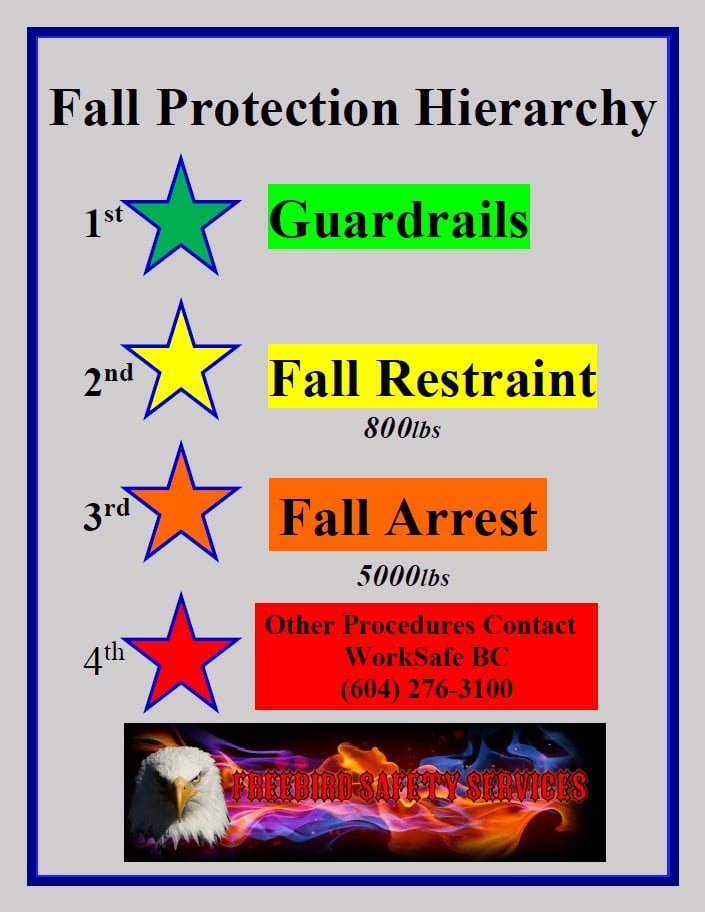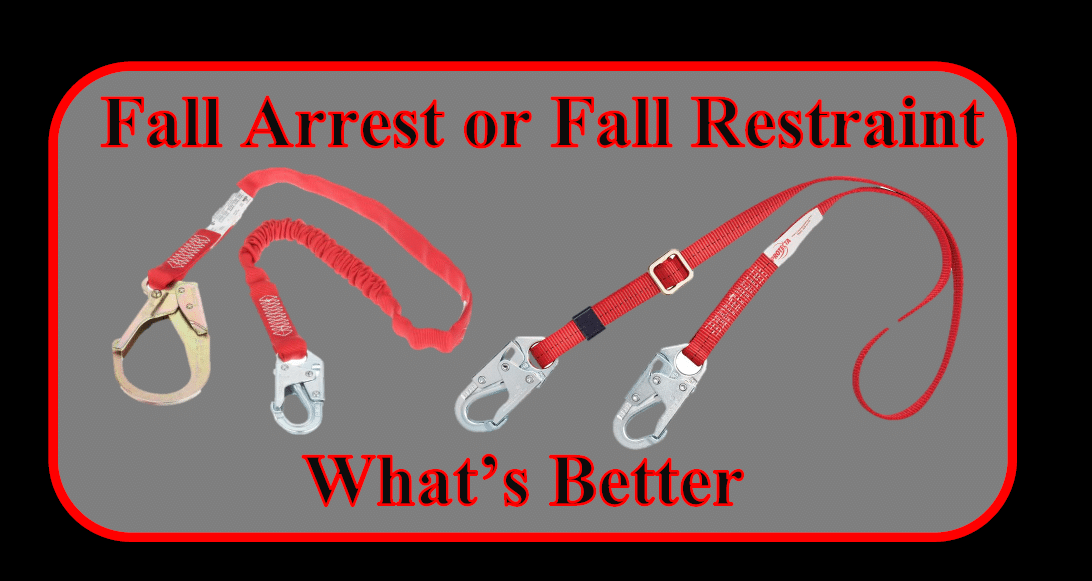Fall Arrest vs Fall Restraint, What’s Better at 10 Feet High
Table of Contents
ToggleFall Arrest vs Fall Restraint, What’s Better at 10 Feet High
There has been lots of discussion on this question. Fall Arrest vs Fall Restraint, What's Better at 10 Feet High? What is your first choice? The numbers are fairly even. However, they are both wrong. You need to look at the Fall Protection Hierarchy. The question between Fall Arrest or Fall Restraint isn't a question of first choice and second choice. These are second and third choices, and fall under PPE. What should always be your first choice. If you don’t know, refer to the Fall Protection Hierarchy.
Guardrails
Your first choice according to the Hierarchy of Fall Protection, should always be Guardrails. This is what I instruct students. Harnesses, lanyards and lifelines all fall under PPE, Personal Protective Equipment. Furthermore, PPE is always considered a backup in case your first line of defense fails. 2 is 1 and 1 is none. Meaning, if you just rely on PPE for protection and it fails, what’s left?

Hierarchy of Fall Protection
If you don't follow the Hierarchy of Fall Protection, you could be looking at a rude awakening.
The Breakdown
This also falls under the Hierarchy of Hazard Controls. Elimination, Substitution, Engineering, Administration and final dead last, PPE. You can’t eliminate it the fall hazard, or substitute it. Guardrails are your engineering controls, a safety meeting while filling out a site-specific fall protection plan is an administration control. Last is your PPE, the harness and related gear. Ever ask yourself why that upside-down triangle at the point labelled PPE is red. Because more people sustain injuries and fatalities when just relying on fall arrest and fall restraint systems.
Tragedy in Saanich
To emphasize this, I’ll refer to a TIMES COLONIST post. On Sept. 15, 2016 in Saanich outside of Victoria on Vancouver Island, a 25-year-old male painter fell hitting the parking lot below. The worker was found at 2:20 pm that day. Vancouver Island regional coroner Matt Brown was called in alone with Worksafe BC. Brown was quoted saying “The man appeared to be wearing a safety harness, but whether it was connected or not, we don’t know. That will be part of the investigation by B.C. Coroners Service and WorkSafe B.C” So he was wearing a harness, yet he fell and hit the ground anyways.
Oveous Answer
The answer is NO he was not correctly connected. Fall Arrest or Fall Restraint, it didn’t matter here. An inadequate anchor, to much stack in a life line, or perhaps he wasn’t even tied off. How many times have workers been spotted wearing a harness yet dragging lanyards around like a tail? Not saying this is the case at all. But a possibility.
Wrong Choices
I’ve seen the building on Google Maps Street View. The fall from the awning wear he was painting is more than 20 feet. Not to mention he was working alone at this height. Another fatal mistake. You never work alone when working at heights while fall arrest or restraint. Always work with a partner, watch each other back and check each other's gear. However, since he was working alone, if had been wearing it right, he still had a 50/50 chance of sustaining serious injuries anyways. And there lies the biggest difference between Fall Arrest and Fall Restraint.
PPE
Fall Restraint
Even though all permanent anchors must be rated at 5000 lbs., in British Columbia Fall Restraint temporary anchors can be as little as 800 lbs. The theory being, if you correctly maintain awareness of the extra length in your lifeline and lanyard, it will only allow you to the leading edge. At that point you won't be allowed to travel any further. That’s why it's called Travel Restraint, also your 2nd choice in Fall Protection. Lanyards have no shock absorber, and come in a variety of lengths. Lifelines and all other connecting devices have to be rated at 5000 lbs. This is because they are all interchangeable with an arrest system. Except the temporary anchors.
The Retractable Lanyard
One of the best connecting devices is the retractable lanyard. Like a seatbelt ratchet, an abnormal sudden pull locks the ratchet. For some reason retractable lanyards also come with a shock absorber. In my opinion this totally defeats the purpose of the device in the first place. Be that as it may, it now is no longer a part of a restraint system. In any event, all arrest connecting devices, anchors, lifelines and lanyards must be rated for 5000 lbs. being your 3rd choice in Fall Protection, an Arrest System is designed to allow slack in the life lines and more freedom of movement. This is the reason why so many like this system.
Fall Arrest
Because Fall Arrest has a shock absorber, workers fell that have more freedom to move. In addition, it's also a system were as the safety harness it self could cause injury or worse. Too much slack and the worker might hit the surface below anyways. Over extending the maximum angle from the anchor of 22 degrees and the results are a swing hazard. Given these points, the worker must always be mindful of the length of free fall in their connection system.
Arrest Allows you to Fall
However, even if they do it right an allow a free fall maximum of 6.5 feet, you better have a rescue plan in place. This is not a think on the fly situation. After a few minutes the worker hanging in their harness will start to develop what’s know as Suspension Trauma, also known as harness hang syndrome. This can cause death after 15 minutes. If the worker in unconscious and not breathing, that number falls to 3 minute max where a worker must be rescued.
Don’t Go Cheap
Under those circumstances there is one other thing to think about. Rule of thumb is the cheaper the harness, the less comfortable it is to wear. Like so many do, people purchase these arrest kits consisting of a lanyard, rope life line, rope grab and harness for around $100. Coming packaged in a 5-gallon pale called a roofer's bucket, the harness is no more than a few straps that wrap the body. Fully CSA approved, yet people never think just how much it'll hurt if they fall. These cheap harnesses will be cinched into your body with an arrest force of 1800 lbs. or more at slack end.
What’s Your Life Worth
Purchase a toolbelt compatible harness with a back-brace work positioning D rings on your hips, (Class P), one on each shoulder (Class E) and of course the one on the back (Class A). In addition, get a set of Trauma Straps. Strapping or heavy line release from pouches on each side of your hip, slipping each foot through to relieve the pressure of the rest of your body and groin. So now you have a good perspective on your choices in fall protection. Ultimately, my choice in a harness and lanyard system, is a Fall Restraint System every time. To many things can go wrong with an arrest system.
If a Fall Does Occur
But remember this, if any of your Personal Fall Protection PPE and related gear is involved in a fall situation, like a baby’s car seat it must be tagged out of service. Not to be used until the manufacturer or their rep. recertifies the gear.
In Closing
What is Better? Fall Arrest or Fall Restraint. The Fall Protection Hierarchy explains your choices. However, to tell you the truth, it really doesn't matter. After this article, I bet you're really confused why I just said that. Well, watch the video in the link from my YouTube channel and your fully understand why I will say this. Just pick one, Fall Arrest or Fall Restraint. Take a training program on how to use it properly, and do it. Also, maintain your Fall Protection Equipment. Now, here's the link to the video.
If a Worker Falls at a Jobsite, Does Industry Really Take Notice - Construction Workers Injured or Killed by Falling from Heights


Pingback: Blogging About Construction Safety, Accidents, WCB Act of BC, Events